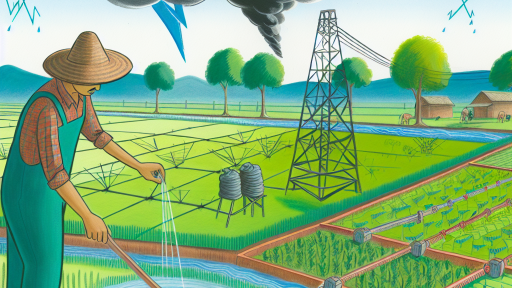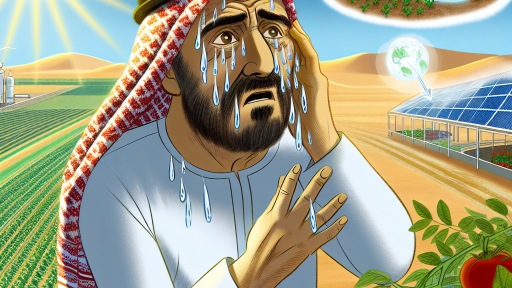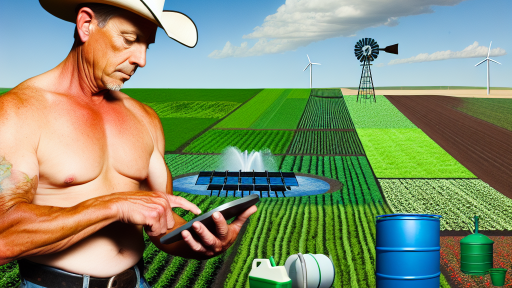Introduction to Climate Change and Its Impact on Agriculture
Climate change poses significant challenges to agriculture worldwide.
Rising temperatures affect crop yields and food production.
Moreover, changing precipitation patterns can cause droughts or flooding.
Farmers need to adapt to these conditions to maintain productivity.
Effects of Temperature Increases
Higher temperatures can lead to heat stress in crops.
This stress reduces crop quality and overall yield.
Certain crops thrive in warmer conditions but many do not.
For example, wheat may suffer in excessively hot environments.
Changing Precipitation Patterns
Altered rainfall affects soil moisture levels.
Insufficient water can cause poor crop germination.
Conversely, excessive rain can erode soil and hinder growth.
Farmers must implement water management strategies.
Pest and Disease Pressure
Climate change influences pest populations and disease spread.
Warmer temperatures may allow pests to thrive in new regions.
This increases the risk of crop damage and loss.
Transform Your Agribusiness
Unlock your farm's potential with expert advice tailored to your needs. Get actionable steps that drive real results.
Get StartedFarmers may need to adopt integrated pest management practices.
Market Responses to Climate Change
Trends in agricultural markets are shifting due to climate factors.
Producers are adjusting to consumer demand for sustainable practices.
This shift often involves investing in climate-resilient technologies.
Market volatility may increase as climate impacts become more pronounced.
Adaptation Strategies
Farmers must adopt new practices to withstand climate challenges.
These strategies include crop rotation and conservation tillage.
Additionally, investing in drought-resistant crop varieties can help.
Collaboration with agricultural experts can aid decision-making.
Overview of Agricultural Market Trends in a Changing Climate
Impact of Climate Change on Crop Production
Climate change significantly affects crop production worldwide.
Weather patterns are becoming increasingly erratic.
This unpredictability challenges farmers’ planning and crop selection.
Moreover, extreme weather events are damaging crops more frequently.
Consequently, farmers are forced to adapt their strategies.
Shifts in Crop Preferences
Farmers increasingly choose crops resilient to changing climates.
These include varieties that withstand drought and flood conditions.
For instance, drought-resistant maize is gaining popularity.
This shift reflects a proactive approach to agricultural sustainability.
Ultimately, adapting crop preferences ensures food security.
Market Demand for Sustainable Practices
Consumer awareness about sustainability is on the rise.
More buyers are seeking organic and sustainably produced food.
This trend drives farmers to adopt environmentally friendly practices.
In turn, this transition can lead to better market prices.
Therefore, embracing sustainable agriculture aligns with market demands.
Showcase Your Farming Business
Publish your professional farming services profile on our blog for a one-time fee of $200 and reach a dedicated audience of farmers and agribusiness owners.
Publish Your ProfileTechnological Advancements in Agriculture
Technology plays a vital role in addressing climate challenges.
Innovations such as precision farming optimize resource use.
Additionally, data analytics helps predict weather patterns.
This allows farmers to make informed planting decisions.
Furthermore, biotechnology enables the development of resilient crop varieties.
Global Trade Dynamics
Climate change is reshaping global agricultural trade.
Regions facing severe impacts may reduce exports.
Consequently, demand for imports may rise in affected areas.
Such shifts influence market prices and availability of products.
Overall, adaptability to these changes is crucial for traders.
Effects of Climate Change on Crop Yields and Production
Shifting Weather Patterns
Climate change alters weather patterns around the globe.
Changes in rainfall affect agricultural productivity.
Decreased precipitation leads to drought in many regions.
Conversely, increased rainfall can cause flooding.
Both extremes result in crop yield variations.
Temperature Variability
Rising temperatures directly impact plant growth.
Crops like wheat and corn require specific temperature ranges.
Excessively high temperatures can harm these plants.
In some areas, heat stress occurs during critical growing phases.
This leads to lower yields and decreased quality.
Pests and Diseases
Climate change influences the distribution of agricultural pests.
Warmer temperatures allow pests to thrive in new areas.
As a result, farmers face increased crop damage.
Furthermore, climate shifts can lead to new disease outbreaks.
These factors contribute to additional financial burdens on farmers.
Soil Health and Erosion
Changes in climate can degrade soil health significantly.
Increased rainfall and flooding lead to erosion.
This reduces the soil’s ability to retain nutrients.
Additionally, drought conditions can cause soil compaction.
Healthy soil is crucial for sustainable agricultural practices.
Food Security Implications
All these factors threaten global food security.
Reduced crop yields can lead to food shortages.
As a result, prices of essential commodities may rise.
Food insecurity could affect millions worldwide.
Urgent action is necessary to mitigate these risks.
Gain More Insights: Climate-Resilient Farming Practices to Save Water
Market Adaptation: How Farmers Are Adjusting to Climate Shifts
Shifting Strategies in Crop Selection
Farmers are increasingly adjusting their crop choices in response to climate changes.
For instance, many are opting for drought-resistant varieties.
This shift allows them to cope with less predictable rainfall patterns.
Moreover, crop rotation practices are becoming more prevalent.
Showcase Your Farming Business
Publish your professional farming services profile on our blog for a one-time fee of $200 and reach a dedicated audience of farmers and agribusiness owners.
Publish Your ProfileThese practices enhance soil health and boost yields over time.
Adaptation also includes diversifying crops to mitigate risks.
This approach helps secure income against crop failures.
Innovations in Farming Techniques
Farmers are leveraging technology to tackle climate challenges.
Precision agriculture tools are gaining popularity across the sector.
These tools enable farmers to monitor field conditions accurately.
Additionally, data analytics supports better decision-making.
Farmers can analyze weather patterns to optimize planting schedules.
Utilizing efficient irrigation systems further reduces water waste.
Financial Strategies for Resilience
Farmers are rethinking their financial strategies to stay viable.
Many are exploring crop insurance options to secure their investments.
Government programs often provide financial assistance during crises.
Moreover, collaborative marketing strategies are emerging.
These strategies enable farmers to pool resources and share risks.
Community Engagement and Support
Building local networks is crucial for farmers facing climate shifts.
Community organizations often provide educational resources.
Farmers can share experiences and strategies through these networks.
Moreover, local governments are increasingly supporting sustainable practices.
These efforts foster innovation and resilience in agriculture.
Delve into the Subject: Impact of Greenhouse Gases on Agricultural Productivity
The Role of Technology in Mitigating Climate Impacts on Agriculture
Precision Agriculture
Precision agriculture leverages modern technology to optimize farming practices.
This approach utilizes GPS and IoT devices to gather real-time data.
Agriculturalists can then make informed decisions based on this information.
As a result, they use resources more efficiently and minimize waste.
This technology also helps in predicting weather patterns accurately.
Climate-Resilient Crop Varieties
Scientists are developing climate-resilient crop varieties through biotechnology.
These crops can withstand extreme weather conditions like drought and flooding.
Farmers can plant these varieties to safeguard their yields against climate change.
This innovation ensures food security amidst changing climatic conditions.
Data Analytics and Big Data
Data analytics plays a crucial role in modern agriculture.
Farmers harness big data to assess soil health and crop performance.
This information allows them to optimize planting schedules and harvest timing.
Consequently, they can increase productivity and reduce operational costs.
Automated Systems and Robotics
Automated systems and robotics are transforming agricultural practices.
Robots can perform tasks such as planting, watering, and harvesting with precision.
This automation reduces labor costs and increases efficiency significantly.
Moreover, it minimizes human error during critical cultivation phases.
Smart Irrigation Systems
Smart irrigation systems aid in conserving water while maximizing crop yields.
These systems use sensors to monitor soil moisture levels continuously.
They adjust water supply accordingly, ensuring crops receive optimal hydration.
Showcase Your Farming Business
Publish your professional farming services profile on our blog for a one-time fee of $200 and reach a dedicated audience of farmers and agribusiness owners.
Publish Your ProfileBy doing so, farmers can withstand periods of drought more effectively.
Monitoring and Reporting Applications
Various applications help farmers monitor their fields remotely.
These tools provide insights into soil health, pest activity, and crop conditions.
Farmers can respond rapidly to emerging issues, reducing the impact of climate change.
Consequently, they maintain crop health and improve yield outcomes.
See Related Content: Climate Change Effects On Farm Profitability

Policy Responses: Government Actions and Support for Farmers
Government Initiatives
Governments worldwide recognize the urgent need to address climate change.
They have implemented various initiatives to support farmers.
These initiatives aim to enhance agricultural resilience.
Moreover, they promote sustainable practices among farmers.
Financial Assistance Programs
Financial assistance is critical for farmers facing climate challenges.
Many governments offer grants and low-interest loans.
These funds help farmers adopt new technologies.
Additionally, they support infrastructure improvements.
Research and Development Investment
Investment in agricultural research is vital for long-term solutions.
Governments fund research on climate-resilient crops.
This research includes soil health and pest management techniques.
Furthermore, it promotes the development of innovative farming practices.
Education and Training Programs
Education plays a key role in empowering farmers.
Training programs help farmers adopt sustainable practices.
These programs also inform them about resource management.
Moreover, they cover the importance of biodiversity.
Collaboration with Agricultural Organizations
Collaboration between governments and agricultural organizations is essential.
These partnerships enhance the effectiveness of climate strategies.
They leverage resources and expertise to support farmers.
Additionally, cooperation fosters knowledge sharing across regions.
Policy Frameworks and Regulations
Clear policy frameworks guide farmers toward sustainable practices.
Regulations often incentivize environmentally friendly actions.
These policies aim to reduce carbon footprints in agriculture.
Ultimately, they support national climate goals.
You Might Also Like: Benefits of Agroforestry for Carbon Sequestration
Consumer Behavior Changes
Impact of Climate Awareness
Climate awareness significantly alters consumer behavior.
More people understand the implications of climate change on food systems.
As a result, consumers increasingly prefer sustainable products.
They focus on organic farming and environmentally friendly practices.
This shift influences agricultural market demand and product offerings.
Shifts in Dietary Preferences
Many consumers are moving towards plant-based diets.
This change stems from concerns over livestock emissions.
Restaurants and grocery stores are adapting to these trends.
Consequently, they offer more vegan and vegetarian options.
Showcase Your Farming Business
Publish your professional farming services profile on our blog for a one-time fee of $200 and reach a dedicated audience of farmers and agribusiness owners.
Publish Your ProfileThis trend directly affects farmers and food manufacturers.
Growing Support for Local Products
Consumers now prioritize locally sourced food items.
This supports local economies and reduces transportation emissions.
Farmers’ markets are witnessing increased foot traffic and sales.
As a consequence, more producers are emphasizing local distribution.
Consumer Education and Engagement
Shoppers are becoming more educated about food origins.
Transparency in supply chains is increasingly demanded.
Brands that communicate sustainability efforts are gaining loyalty.
Interactive labeling helps educate consumers about product impact.
Social Media and Advocacy
Social media platforms amplify climate-related messages.
Consumers rally around brands that promote sustainability.
This advocacy influences purchasing decisions at unprecedented levels.
Consequently, interactive campaigns can enhance a brand’s visibility.
Future Projections: Expected Trends in Agriculture and Markets Due to Climate Change
Shifts in Crop Production
Climate change significantly alters crop production patterns.
Farmers increasingly adapt to changing weather conditions.
For instance, warmer temperatures may favor crops like sorghum and millet.
Moreover, traditional crops might struggle in hotter climates.
Consequently, growers will need to diversify crop selections.
Impact on Livestock Farming
Livestock farming faces unique challenges from climate change.
Changes in feed availability can adversely affect animal health.
Higher temperatures can lead to heat stress in livestock.
Therefore, farmers must implement innovative cooling techniques.
Additionally, breeding programs may need to prioritize heat resistance.
Market Fluctuations
Climate-related disruptions can cause significant market fluctuations.
Extreme weather events often lead to supply shortages.
This situation drives prices up for consumers and businesses alike.
Markets will increasingly react to climate forecasts and trends.
Investors may seek opportunities in climate-resilient agricultural products.
Emerging Agricultural Technologies
Technological advancements will play a crucial role in adaptation.
Precision agriculture can enhance resource efficiency.
Data analytics will help farmers make informed decisions quickly.
Innovative irrigation methods ensure water conservation.
Robotics may streamline labor-intensive processes in farming.
Regulatory and Policy Changes
Policymakers will likely respond to the challenges posed by climate change.
New regulations may promote sustainable farming practices.
Subsidies could support farmers transitioning to resilient crops.
International cooperation may become vital for effective solutions.
Furthermore, educational programs will inform farmers about best practices.
Consumer Preferences
Climate change influences consumer food choices and preferences.
More individuals are seeking sustainable and locally sourced foods.
Showcase Your Farming Business
Publish your professional farming services profile on our blog for a one-time fee of $200 and reach a dedicated audience of farmers and agribusiness owners.
Publish Your ProfileThis shift will encourage producers to adopt greener practices.
Moreover, consumers may prioritize organic and climate-friendly options.
As a result, the demand for transparency in food sourcing will rise.
Additional Resources
Evaluating the effects of climate change on US agricultural systems …
Climate Impacts on Agriculture and Food Supply | Climate Change …




